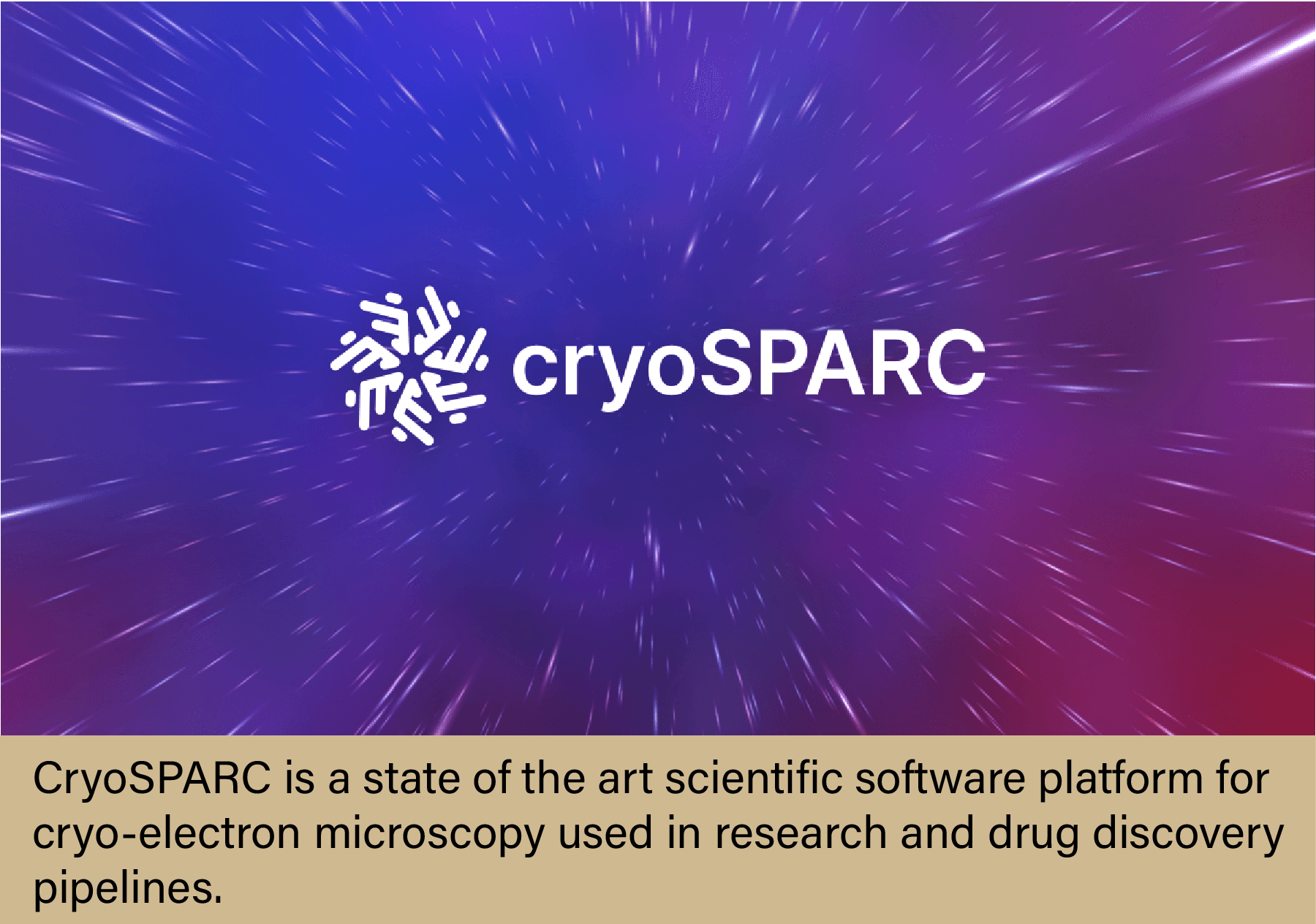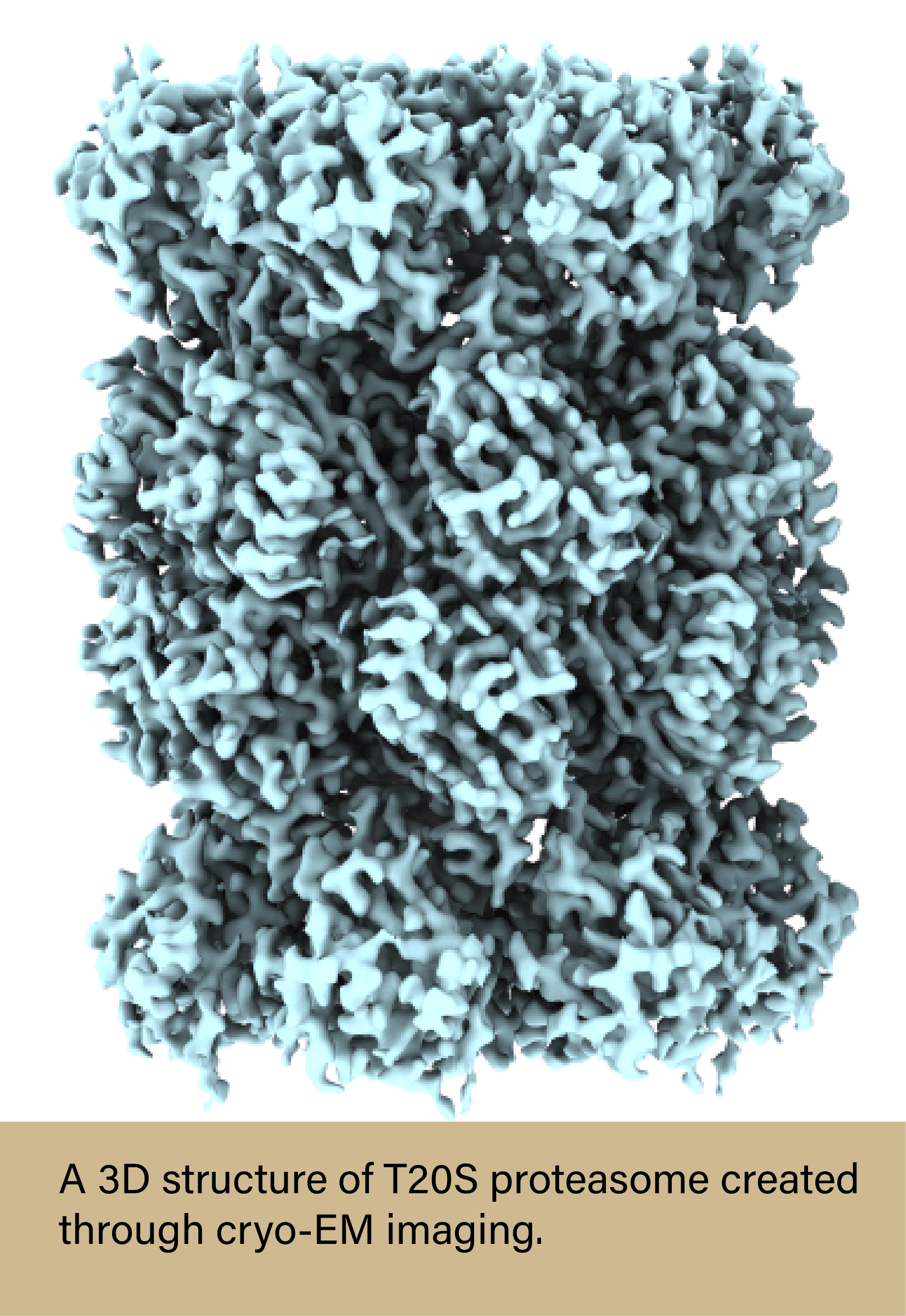Introducing CryoSPARC: Anvil’s powerful new software aimed at bioscience research
The Anvil supercomputer has recently received a full integration of  CryoSPARC, a state-of-the-art HPC software solution designed to enable the complete processing of single-particle cryo-electron microscopy (cryo-EM) data. With this new addition to an already extensive software catalog, Anvil is now poised to explore new frontiers in bioscience research.
CryoSPARC, a state-of-the-art HPC software solution designed to enable the complete processing of single-particle cryo-electron microscopy (cryo-EM) data. With this new addition to an already extensive software catalog, Anvil is now poised to explore new frontiers in bioscience research.
Cryo-electron microscopy, or cryo-EM, is a version of electron microscopy in which delicate samples, such as proteins, viruses, DNA, RNA, or molecular structures within a cell, are cryogenically frozen into a glassy state before being observed and imaged under the microscope. Freezing the samples in this way allows for a higher-resolution image. Thousands of these images are taken and combined to create 3D models with unprecedented levels of atomic detail. Cryo-EM has revolutionized the world of structural biology and, in many instances, has become the go-to method for structural analysis of specific biological samples. But acquiring this level of 3D detail comes at a cost.
Taking thousands of images of a single sample is necessary for creating a high-resolution 3D image, but it also produces an astounding amount of data that needs to be processed before reaching that endpoint. A high-performance computing (HPC) system is extraordinarily helpful in ensuring that the research can be completed in a timely manner, but having HPC access won’t be of much use if the supercomputer doesn’t have the appropriate software. Anvil has solved this problem by completely integrating CryoSPARC and CryoSPARC Live, software platforms that handle all aspects of cryo-EM data.
The CryoSPARC (Cryo-EM Single Particle Ab-Initio Reconstruction and Classification) software is a globally trusted complete solution for cryo-EM data processing. It combines powerful innovations in 3D reconstruction algorithms with specially designed software to provide a streamlined end-to-end single-particle cryo-EM workflow. With CryoSPARC, researchers can rapidly solve high-resolution structures of biologically important targets, utilize advanced tools for membrane proteins, heterogeneous samples, and flexible molecules, and process 3D refinements in minutes on Anvil’s powerful GPUs. CryoSPARC Live allows you to utilize these tools in real-time, giving researchers the ability to experiment with parameters on the fly. These two software platforms enable:
•Real-time cryo-EM data quality assessment and decision-making during live data collection, as well as an expedited, streamlined workflow for processing already available data
•Ultra-fast end-to-end processing of raw cryo-EM data and reconstruction of electron density maps, ready for ingestion into model-building software
•Optimized algorithms and GPU acceleration at all stages, from pre-processing through particle picking, 2D particle classification, 3D ab-initio structure determination, high-resolution refinement, and heterogeneity analysis
•Specialized and unique tools for therapeutically relevant targets, membrane proteins, and continuously flexible structures
•Interactive, visual, and iterative experimentation for even the most complex workflows
Both CryoSPARC and CryoSPARC live are centrally deployed on Anvil.  The limited availability or versatility of CryoSPARC on HPC clusters have been an obstacle towards its adoption. Anvil offers easy access and use of the software through the Open OnDemand platform. Open OnDemand gives researchers remote web access to supercomputers such as Anvil, and allows the researchers to utilize any software programs centrally deployed on the supercomputer from anywhere in the world with just a few clicks of a button. And thanks to the work of the Anvil team, instead of spending time trying to install and optimize CryoSPARC on a personal computer or on an HPC cluster elsewhere, researchers can get instant access so that they can stay focused on doing their research.
The limited availability or versatility of CryoSPARC on HPC clusters have been an obstacle towards its adoption. Anvil offers easy access and use of the software through the Open OnDemand platform. Open OnDemand gives researchers remote web access to supercomputers such as Anvil, and allows the researchers to utilize any software programs centrally deployed on the supercomputer from anywhere in the world with just a few clicks of a button. And thanks to the work of the Anvil team, instead of spending time trying to install and optimize CryoSPARC on a personal computer or on an HPC cluster elsewhere, researchers can get instant access so that they can stay focused on doing their research.
Another benefit of using CryoSPARC on Anvil stems from the fact that the CryoSPARC software can process data on the GPUs available on the supercomputer. Anvil has 16 GPU nodes, each with four NVIDIA A100 Tensor Core GPUs. These GPU nodes provide an additional 1.5 PF of single-precision performance. Using CryoSPARC on Anvil takes advantage of these advanced GPUs, saving the researcher both time and effort while they complete their cryo-EM research.
Cryo-EM is a powerful approach to structural biology research, and CryoSPARC is a perfect processing tool for cryo-EM data. Now that Anvil has received a full integration of this amazing software, researchers can utilize CryoSPARC to its fullest potential, making new breakthroughs and discoveries faster and easier than ever before.
How to do cryo-EM research on Anvil?
The Anvil supercomputer is available to researchers through the NSF-funded program known as Advanced Cyberinfrastructure Coordination Ecosystem: Services & Support (ACCESS), which manages access to national cyberinfrastructure (CI) resources. Any researcher who seeks to use one of these CI resources must follow ACCESS processes to get onto these resources. For those who want to use Anvil for their cryo-EM research, please visit our ACCESS allocations process page for more information on how to get started.
Open OnDemand is an open-source HPC portal developed by the Ohio Supercomputer Center. Open OnDemand allows one to interact with HPC resources through a web browser and easily manage files, submit jobs, and interact with graphical applications directly in a browser, all with no software to install. For more information on how to use Open OnDemand for running your cryo-EM jobs, please visit our Open OnDemand User Guide. CryoSPARC is supported within Open OnDemand on Anvil and allows researchers to use this software while leveraging the CPU and GPU resources provided by Anvil.
CryoSPARC is developed and distributed by Structura Biotechnology Inc. More information about the software can be found at https://guide.cryosparc.com. Researchers must obtain a license before use. CryoSPARC and CryoSPARC Live are available free of charge for non-profit academic research. More information on how to obtain a license can be found on the CryoSPARC Licensing webpage.
Anvil is Purdue University’s most powerful supercomputer, providing researchers from diverse backgrounds with advanced computing capabilities. Built through a $10 million system acquisition grant from the National Science Foundation (NSF), Anvil supports scientific discovery by providing resources through the NSF’s Advanced Cyberinfrastructure Coordination Ecosystem: Services & Support (ACCESS), a program that serves tens of thousands of researchers across the United States. More information about Anvil is available on Purdue’s Anvil website. Anyone with questions should contact anvil@purdue.edu. Anvil is funded under NSF award No. 2005632.
Written by: Jonathan Poole, poole43@purdue.edu
